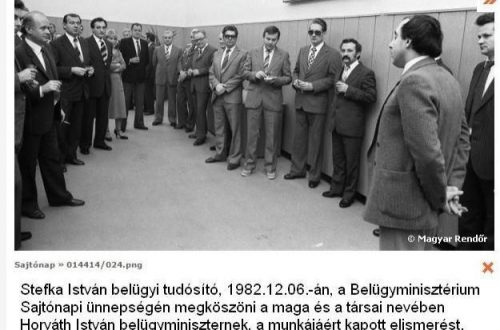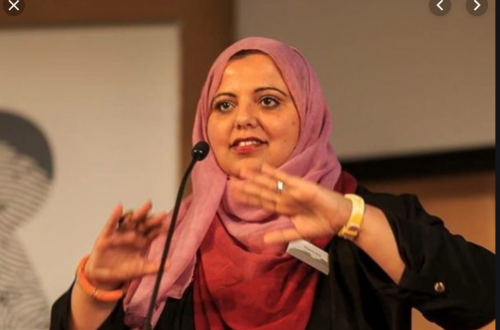Guest post by Karl Pfeifer
The 25 years that have passed since regime change and the more than two decades since the creation of an independent Slovakia were characterized by dismantling of an authoritarian regime. A generational change took place: introduction of a democratic regime, strengthening of civil society, transition from a planned economy to a market economy and free enterprise, as well as accession to NATO, the EU and the euro zone.
However in all the countries in the region that were allies of Nazi Germany during World War II, the past continues to cast its shadow.
In Slovakia and Croatia, the only modern experience of independence before the 1990s happened during World War II, when both countries were led by clerical fascists allied to the Nazis. Following the collapse of Communism, many Croats, Hungarians, Slovaks and Romanians see the rehabilitation of wartime collaborationist leaders as a way to reconnect to this tradition and reinforce their national aspiration.
The pro-Nazi Roman Catholic priest Jozef Tiso, as the president of the wartime Slovak state, was responsible for the deportation of more than 70.000 Jews to their deaths after 1942. After Slovakia became fully independent on January 1, 1993, the desire to rehabilitate Tiso was closely entwined with the Slovak nationalist drive for state sovereignty and closely linked to anti-Semitism. Nationalist and clerical-fascist Slovak exiles returning from abroad after 1989 dedicated themselves to honoring the memory of Tiso as a national hero and martyr who had fallen victim to perfidious Communist executioners.
Their efforts were countered by diametrically opposed attempts to admit Slovak complicity in the Holocaust for the first time and to commemorate the tragedy of the murdered Jews. Surveys show that a majority of Slovaks do accept that Tiso-era politicians had some responsibility for the extermination of the Jews. At the same time, the image of the Jew in the context of anti-Semitic discourse has not changed very much. The classical image of the power-hungry, cunning Jew, manipulating the economy and politics, has not only survived one quarter of a century of democratic development, but has adapted itself to current reality – it is now of the Jew promoting and benefiting from globalization, in a wider context of an “evil” Israel. It seems the oldest “lethal obsession” is still alive and well, and hinders the liberation of a new generation from the prejudice that gave birth to a tragedy
When discussing the role of the Catholic Church played in preventing or assisting the persecution before and during the Holocaust, some defend the Church, while others denounce it. Unbiased historians found out that during the 1930s in Poland, Hungary, Slovakia and Croatia the Church agreed with clerical-fascist proposals to restrict Jewish activities in finance, commerce and the free professions. Some clerics in these countries considered Jews subversive, dangerous and immoral.
The Hlinka’s Slovak People’s Party, a far from homogeneous organization, ruled Slovakia from March 14, 1939, when Slovakia became the first satellite of the Third Reich until April 1945. Within the party, two currents competed for power: the clericals, led by Jozef Tiso, and the Radicals under Prof. Vojtech (Béla) Tuka and Alexander (Sano) Mach. When Tiso was elevated to the presidency in October 1939, Tuka became Prime Minister, a post retained until September 1944. The clericals and the radicals competed for German favor. Both were eager to rid Slovakia of Jews.
In State and Party the clergy was well represented, and even within the cabinet, clericals outnumbered radicals. The clergy constituted the backbone of Slovak nationalism as represented by Hlinka’s party. Without its active participation the activities of the party, and particularly of its clerical wing, would have been impossible. Not all Slovakian clerics identified themselves with Tiso. A sizable group, composed mainly of young priests, was closer to Tuka than to Tiso. On the other hand, some priests and outstanding Catholic nonprofessionals joined democratic and anti-Nazi forces.
George F. Kennan, who served as Secretary of the United States Legation in Prague between 1938 and 1939, on February 17, 1939 reported on the situation of the Jews in what was still autonomous Slovakia. Discussing the Catholics, he wrote “… it is evident that the Slovak leaders will encounter little opposition from the Church in promulgation of an anti-Semitic policy.” His statement remained valid as late as autumn of 1941. Although the clergy was well represented in the legislative bodies, anti-Jewish laws continued to be enacted. When the government issued the various “aryanization” laws, Church institutions and clergy did not hesitate to take advantage of the ominous legislation. Tiso, the president, promulgated the first racist anti-Semitic legislation in 1939 and 1940. Until then the Vatican was not concerned about the events in Slovakia. It was pleased to see a new Catholic state in Eastern Europe. Pope Pius XII extended an apostolic blessing to President Tiso. The Vatican did not like the next year’s anti-Semitic actions. The Jewish Code passed in September 1941 was based on the Nuremberg Laws, even surpassing them in severity in some areas. The Vatican’s concern was for the rights of Jewish converts; restrictions on marriages between Jews and Catholics upset Rome. The Slovakian bishops also deplored the Jewish Code, but went further, telling Tiso that he acted against the principles of religion by persecuting people on basis of race. The Nazis were pleased that such a legislation could appear in an administration headed by a priest. Interior Minister Mach retreated under pressure from the Episcopate and moderated the implementation of several paragraphs.
When the Jewish community reacted to imminent deportations by appealing to Tiso as a priest and civic leader to intervene, his reply was to launch an investigation into how the Jews had found out about the plan. The Vatican disapproved of Tiso, and Monsignor Tardini of the secretariat of state remarked that although everyone understands that the Holy See cannot displace Hitler, no one would understand if it was unable to restrain a priest.
(After the war, Cardinal Michael Faulhaber of Munich protected Tiso, who had fled via Austria to Germany. He wrote to the US Military Administration, Munich June 9, 1945: “I feel duty bound to notify the Holy Father of [your] arrest of Dr. Tiso, since as a prelate in good standing he is a member of the papal family.”)
Slovakia was also the first Axis partner to consent to the deportation of its Jewish residents in the framework of the “Final Solution”. Before deportation the Jewish community contacted the Vatican chargé d’affaires in Bratislava, Msgr. Giuseppe Burzio, and Provincials of the Jesuit and Franciscan orders, bishops and a long list of clergymen.
The bishops met in the city of Nitra and composed a collective letter of protest to the government and the president. The Episcopate also prepared a pastoral letter, but it was never read as the government opposed its publication. However, an official statement was published in the organ of the Church, Katolické Noviny, on April 26, 1942 (a month after the departure of the first transport). It was a strange document. On the one hand, it said, “One should take particular care not to transgress the legal order and the laws of Nature and God.” On the other hand, it denied Church opposition to “…legal actions of the government while it is taking steps to eradicate the evil influence of the Jews.” The document commented: “The source of the tragedy of the Jewish people is the fact that they did not recognize the Messiah and prepared for him a horrible and infamous death on the cross.”
A German document singles out the Catholic Bishop of Spis, Msgr. Jan Vojtaššák, as forcefully supporting the deportations.
According to a census of December 15, 1940, there were about 88,951 Jews in Slovakia. In March 1942, Slovakia signed an agreement with Germany that permitted the deportation of the Slovak Jews.
Between March and October 1942, Slovak gendarmes, assisted by Slovak military personnel, units of the Slovak People’s Party’s paramilitary organization, the Hlinka Guard, and members of the Slovak ethnic German paramilitary formation Freiwillige Schutzstaffel (Volunteer SS), concentrated more than 57,000 Slovak Jews in indigenously established labor and concentration camps– mainly in the Sered, Novaky, and Vyhne. Slovakia agreed to pay 500 Reichsmarks for every deported Jew, provided his property would be taken over by Slovakia.
The Slovak authorities transported the Jews to the border of the Government General or the German Reich and turned them over to German SS and police. The Nazis killed virtually all of these Jews in Auschwitz-Birkenau, Lublin/Majdanek, Sobibor, and other locations in German-occupied Poland. Perhaps 300 survived the war from first transports in 1942. Among them were Alfred Wetzler and Walter Rosenberg (alias Rudolf Vrba), who escaped from Auschwitz in the spring of 1944 and compiled the first detailed report on operations there for general dissemination in the West.
The Slovak state hesitated after October 1942 to deport the remaining Jews. During the deportations, some 6,000 Slovak Jews escaped to Hungary. On August 29, 1944, however, Slovak underground resistance organizations, Communist and non-Communist, rose against the Tiso regime as Soviet troops were at the borders of Slovakia.
As the Slovak authorities were helpless to quell the uprising, German troops moved in. Einsatzgruppe H of the Security Police and SD, whose duties included rounding up and killing or deporting the remainder of the Slovak Jews, accompanied the Wehrmacht into Slovakia. Between September 1944 and the end of the year, German units deported approximately 12,600 Slovak Jews, most of them to Auschwitz, Theresienstadt, and other camps in Germany. German and Hlinka Guard units killed a few thousand Jews caught in hiding or fighting with the partisans in Slovakia.
Perhaps half of the Jews deported out of Slovakia during and just after the uprising ended in October 1944 survived. Thousands of Jews remained in hiding in Slovakia. In all, German and Slovak authorities deported more than 70,000 Jews from Slovakia.
Sources:
Yeshajahu Jelinek: The Vatican, the Catholic Church, the Catholics and the Persecution of the Jews during World War II: The Case of Slovakia in Jews and non-Jews in Eastern Europe, Keter, 1974
Tatjana Tönsmeyer: Das Dritte Reich und die Slowakei 1939-1945


